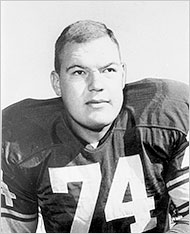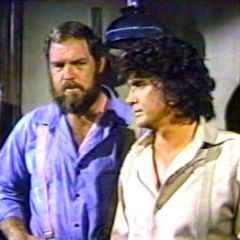Difference between revisions of "Merlin Olsen"
Dennisangot (talk | contribs) |
|||
| Line 1: | Line 1: | ||
[[Image:Merlin_Olsen.jpg|right|150px|alt=Mormon Football Player Merlin Olsen]] | [[Image:Merlin_Olsen.jpg|right|150px|alt=Mormon Football Player Merlin Olsen]] | ||
| − | '''Merlin Jay Olsen''' was considered one of the greatest tackles in N.F.L. history, but he also forged careers in broadcasting and acting. He was a longtime color commentator for NBC’s pro football and Rose Bowl telecasts, working with Dick Enberg, and he acted on television, most prominently in NBC’s “Little House on the Prairie” and in his own series, “Father Murphy.” He was a member of [[The Church of Jesus Christ of Latter-day Saints]], the Mormon Church. Merlin was born September 19, 1940, to Lynn Jay and Merle Barrus Olsen in Logan, Utah. Three of the Olsen brothers, Merlin, Phil, and Orrin, played in the NFL, with Merlin and Phil Olsen playing together for the Rams from 1971–1974. A nephew, Hans, son of his brother, Clark, also played professional football. | + | '''Merlin Jay Olsen''' was considered one of the greatest tackles in N.F.L. history, but he also forged careers in broadcasting and acting. He was a longtime color commentator for NBC’s pro football and Rose Bowl telecasts, working with Dick Enberg, and he acted on television, most prominently in NBC’s “Little House on the Prairie” and in his own series, “Father Murphy.” He was a member of [[The Church of Jesus Christ of Latter-day Saints]], sometimes casually called the Mormon Church. Merlin was born September 19, 1940, to Lynn Jay and Merle Barrus Olsen in Logan, Utah. Three of the Olsen brothers, Merlin, Phil, and Orrin, played in the NFL, with Merlin and Phil Olsen playing together for the Rams from 1971–1974. A nephew, Hans, son of his brother, Clark, also played professional football. |
Olsen attended Utah State University and was a three-year letterman in football as a defensive tackle. In football, as a senior, he was a consensus All-American selection (making the vast majority of All-America teams) and was the winner of the Outland Trophy. After Olsen's junior year of 1960 he was also named All-American by the Football Writers Association of America and Newspaper Enterprise Association. He was also All-Conference in both 1960 and 1961 ([http://en.wikipedia.org/wiki/Merlin_Olsen Wikipedia]). | Olsen attended Utah State University and was a three-year letterman in football as a defensive tackle. In football, as a senior, he was a consensus All-American selection (making the vast majority of All-America teams) and was the winner of the Outland Trophy. After Olsen's junior year of 1960 he was also named All-American by the Football Writers Association of America and Newspaper Enterprise Association. He was also All-Conference in both 1960 and 1961 ([http://en.wikipedia.org/wiki/Merlin_Olsen Wikipedia]). | ||
Revision as of 18:17, 12 September 2011
Merlin Jay Olsen was considered one of the greatest tackles in N.F.L. history, but he also forged careers in broadcasting and acting. He was a longtime color commentator for NBC’s pro football and Rose Bowl telecasts, working with Dick Enberg, and he acted on television, most prominently in NBC’s “Little House on the Prairie” and in his own series, “Father Murphy.” He was a member of The Church of Jesus Christ of Latter-day Saints, sometimes casually called the Mormon Church. Merlin was born September 19, 1940, to Lynn Jay and Merle Barrus Olsen in Logan, Utah. Three of the Olsen brothers, Merlin, Phil, and Orrin, played in the NFL, with Merlin and Phil Olsen playing together for the Rams from 1971–1974. A nephew, Hans, son of his brother, Clark, also played professional football.
Olsen attended Utah State University and was a three-year letterman in football as a defensive tackle. In football, as a senior, he was a consensus All-American selection (making the vast majority of All-America teams) and was the winner of the Outland Trophy. After Olsen's junior year of 1960 he was also named All-American by the Football Writers Association of America and Newspaper Enterprise Association. He was also All-Conference in both 1960 and 1961 (Wikipedia).
The Aggies, not known as a national power football program, finished 10th in both the AP and UPI post-season polls, the only time that has occurred in school history. The Aggies had a combined 18–3–1 record during Olsen's junior and senior seasons under coach John Ralston and were conference champions those two seasons as well.
Olsen played in the East-West Shrine Game in 1961 and in 2003 was voted to the game's Hall of Fame. He also played in the Hula Bowl after his senior season and was voted MVP of the game. Olsen is a member of the State of Utah’s Sports Hall of Fame, the Utah State University Sports Hall of Fame and USU’s All-Century Football Team. In 2000, he was selected by Sports Illustrated as one of the State of Utah’s Top 50 Athletes of the Century. He was voted to the All-Academic All-America Hall of Fame in 1988. In 1969 he was voted to the Newspaper Enterprise Association All-Time All-America team with collegiate greats such as Bronco Nagurski, Red Grange, Jim Thorpe, and O.J. Simpson, among others. Olsen also was a three-time academic All-American at Utah State and graduated summa cum laude and Sigma Chi in 1962 with a degree in finance.
After playing college ball, Olsen signed with the Rams. He was the first Utah State Aggie football player ever to be drafted in the first round. He played for the Los Angeles Rams from 1962 to 1976. He was named the NFL's Rookie of the Year in 1962 and was First-team All-Pro in 1964, and 1966 through 1970. He was voted Second-team All-Pro in 1965, 1973 and 1974. He was never plagued by injuries, missing only two games in fifteen seasons. he became part of one of the best front fours in NFL history. Deacon Jones, Rosey Grier, and Lamar Lundy joined Olsen on the defensive line in 1963 that was nicknamed "The Fearsome Foursome". Throughout the 1960s, this quartet terrorized opposing offenses.
In 1973 Olsen was voted the NFLPA NFC Defensive Lineman of the Year and the next season, 1974, he was the recipient of Bert Bell Award as the NFL MVP as voted by the Maxwell Club. Olsen made the Pro Bowl a record 14 times throughout his career. He was inducted into the Pro Football Hall of Fame in 1982. In 1999, he was ranked number 25 on The Sporting News' list of the 100 Greatest Football Players.
Post Retirement
Olsen enjoyed continued success after the NFL as a broadcaster, actor and businessman. He served as a television color commentator, teaming with Dick Enberg on NBC's coverage of the AFC throughout the 1980s. In 1990 and 1991, he moved to CBS Sports doing NFL games with Dick Stockton.
Olsen developed a successful career as an actor. He costarred on Little House on the Prairie, and then went on to star in Father Murphy for two seasons. Olsen's last acting work was in the short-lived 1988 TV series Aaron's Way, in which he played the lead role. Olsen has often co-hosted the Children's Miracle Network telethons, a humanitarian organization founded in 1983 by Marie Osmond and John Schneider. Olsen was also the commercial spokesman for FTD Florists for many years. A part-time resident of the Coachella Valley, Olsen was the longtime radio and television spokesman for Palm Desert-based El Paseo Bank.
Olsen married Susan Wakley on March 30, 1962, and they had three children: Kelly, Jill, and Nathan, and four grandchildren. Olsen passed away on March 11, 2010.

